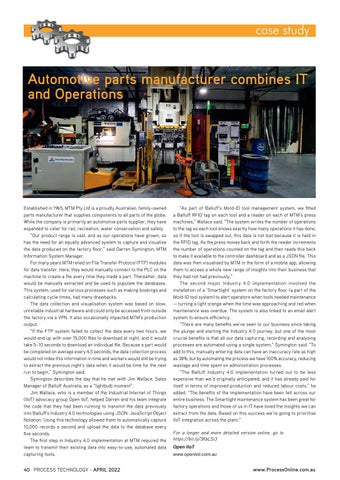case study
Automotive parts manufacturer combines IT and Operations
Established in 1965, MTM Pty Ltd is a proudly Australian, family-owned parts manufacturer that supplies components to all parts of the globe. While the company is primarily an automotive parts supplier, they have expanded to cater for rail, recreation, water conservation and safety. “Our product range is vast, and as our operations have grown, so has the need for an equally advanced system to capture and visualise the data produced on the factory floor,” said Darren Symington, MTM Information System Manager. For many years MTM relied on File Transfer Protocol (FTP) modules for data transfer. Here, they would manually connect to the PLC on the machine to create a file every time they made a part. Thereafter, data would be manually extracted and be used to populate the databases. This system, used for various processes such as making bookings and calculating cycle times, had many drawbacks. The data collection and visualisation system was based on slow, unreliable industrial hardware and could only be accessed from outside the factory via a VPN. It also occasionally impacted MTM’s production output. “If the FTP system failed to collect the data every two hours, we would end up with over 15,000 files to download at night, and it would take 5–10 seconds to download an individual file. Because a part would be completed on average every 4.5 seconds, the data collection process would not index this information in time and workers would still be trying to extract the previous night’s data when it would be time for the next run to begin,” Symington said. Symington describes the day that he met with Jim Wallace, Sales Manager of Balluff Australia, as a “lightbulb moment”. Jim Wallace, who is a member of the Industrial Internet of Things (IIoT) advocacy group Open IIoT, helped Darren and his team integrate the code that they had been running to transmit the data previously into Balluff’s Industry 4.0 technologies using JSON: JavaScript Object Notation. Using this technology allowed them to automatically capture 10,000 records a second and upload the data to the database every five seconds. The first step in Industry 4.0 implementation at MTM required the team to transmit their existing data into easy-to-use, automated data capturing tools.
40 PROCESS TECHNOLOGY - APRIL 2022
“As part of Balluff’s Mold-ID tool management system, we fitted a Balluff RFID tag on each tool and a reader on each of MTM’s press machines,” Wallace said. “The system writes the number of operations to the tag so each tool knows exactly how many operations it has done, so if the tool is swapped out, this data is not lost because it is held in the RFID tag. As the press moves back and forth the reader increments the number of operations counted on the tag and then reads this back to make it available to the controller dashboard and as a JSON file. This data was then visualised by MTM in the form of a mobile app, allowing them to access a whole new range of insights into their business that they had not had previously.” The second major Industry 4.0 implementation involved the installation of a ‘Smartlight’ system on the factory floor (a part of the Mold-ID tool system) to alert operators when tools needed maintenance — turning a light orange when the time was approaching and red when maintenance was overdue. The system is also linked to an email alert system to ensure efficiency. “There are many benefits we’ve seen to our business since taking the plunge and starting the Industry 4.0 journey, but one of the most crucial benefits is that all our data capturing, recording and analysing processes are automated using a single system,” Symington said. “To add to this, manually entering data can have an inaccuracy rate as high as 38%, but by automating the process we have 100% accuracy, reducing wastage and time spent on administration processes. “The Balluff Industry 4.0 implementation turned out to be less expensive than we’d originally anticipated, and it has already paid for itself in terms of improved production and reduced labour costs,” he added. “The benefits of the implementation have been felt across our entire business. The Smartlight maintenance system has been great for factory operations and those of us in IT have loved the insights we can extract from the data. Based on this success we’re going to prioritise IIoT integration across the plant.” For a longer and more detailed version online, go to https://bit.ly/3KbLSi3 Open IIoT www.openiiot.com.au
www.ProcessOnline.com.au
